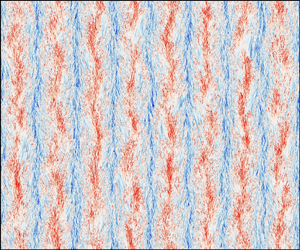Article contents
Localizing effect of Langmuir circulations on small-scale turbulence in shallow water
Published online by Cambridge University Press: 17 April 2020
Abstract

Wall-resolved and wall-modelled large-eddy simulations are performed to study the localizing effect of Langmuir cells (LCs) on small-scale background turbulence in shallow water. The total velocity fluctuations are decomposed into an LC content extracted by streamwise averaging and a background turbulence part. Based on the large-scale motions of LCs, the spanwise domain is divided into three regions dominated by the upwelling, spanwise and downwelling flows of LCs, respectively. The localized Reynolds stresses  $\langle u_{i}^{T}u_{j}^{T}\rangle _{xt}$ in different spanwise regions are compared to show the localizing effects of the LCs on the background turbulence quantitatively, where
$\langle u_{i}^{T}u_{j}^{T}\rangle _{xt}$ in different spanwise regions are compared to show the localizing effects of the LCs on the background turbulence quantitatively, where  $u_{1}^{T}$ (or
$u_{1}^{T}$ (or  $u^{T}$),
$u^{T}$),  $u_{2}^{T}$ (or
$u_{2}^{T}$ (or  $v^{T}$) and
$v^{T}$) and  $u_{3}^{T}$ (or
$u_{3}^{T}$ (or  $w^{T}$) represent the streamwise, vertical and spanwise components of the background turbulence velocity, respectively, and
$w^{T}$) represent the streamwise, vertical and spanwise components of the background turbulence velocity, respectively, and  $\langle \cdot \rangle _{xt}$ denotes time and streamwise averaging. It is shown that the magnitudes of the localized Reynolds stresses in different spanwise regions vary significantly. The transport equations of the localized Reynolds stresses are then analysed to investigate the mechanisms underlying the localizing effects. It is discovered that the difference in the energy production correlated to the shear of the LC content among different regions is the key factor that leads to the localization of background turbulence. In addition, the energy production correlated to the shear of the mean flow, the energy redistribution due to the pressure–strain correlation, and the interaction between the localized Reynolds stresses and the shear of the Stokes drift also play important roles. Based on the results obtained from the analysis of the transport equations, predictive models are proposed for the localizing effects, which assess the spatial dependence of the Boussinesq model for background turbulence in coastal Langmuir turbulence. These models show good scaling performance of
$\langle \cdot \rangle _{xt}$ denotes time and streamwise averaging. It is shown that the magnitudes of the localized Reynolds stresses in different spanwise regions vary significantly. The transport equations of the localized Reynolds stresses are then analysed to investigate the mechanisms underlying the localizing effects. It is discovered that the difference in the energy production correlated to the shear of the LC content among different regions is the key factor that leads to the localization of background turbulence. In addition, the energy production correlated to the shear of the mean flow, the energy redistribution due to the pressure–strain correlation, and the interaction between the localized Reynolds stresses and the shear of the Stokes drift also play important roles. Based on the results obtained from the analysis of the transport equations, predictive models are proposed for the localizing effects, which assess the spatial dependence of the Boussinesq model for background turbulence in coastal Langmuir turbulence. These models show good scaling performance of  $\langle u^{T}u^{T}\rangle _{xt}$ near the water bottom and of
$\langle u^{T}u^{T}\rangle _{xt}$ near the water bottom and of  $\langle -u^{T}v^{T}\rangle _{xt}$,
$\langle -u^{T}v^{T}\rangle _{xt}$,  $\langle -u^{T}w^{T}\rangle _{xt}$ and
$\langle -u^{T}w^{T}\rangle _{xt}$ and  $\langle -v^{T}w^{T}\rangle _{xt}$ in the central region of the water column under various flow conditions with different values of the Reynolds number, turbulent Langmuir number and wavenumber.
$\langle -v^{T}w^{T}\rangle _{xt}$ in the central region of the water column under various flow conditions with different values of the Reynolds number, turbulent Langmuir number and wavenumber.
JFM classification
- Type
- JFM Papers
- Information
- Copyright
- © The Author(s), 2020. Published by Cambridge University Press
References
- 3
- Cited by




